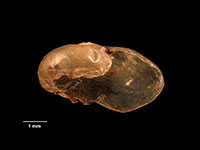Compare Timbellus bilobatus
| toggle to add to compare list |
Taxonomy
Family: Subfamily: MURICIDAE: MURICINAE Full Classification: |
Images: Timbellus bilobatus Houart, 2012
Taxonomy
Family: Subfamily: MURICIDAE: MURICINAE Full Classification: |
Details: Timbellus bilobatus Houart, 2012
Distribution:
Kermadec Islands to New Caledonia
Geographical Range:
K
Notes:
Species Links
Distribution Map
References and Publications
- Marshall, B.A., Houart, R. 2012 The Recent Typhinae (Gastropoda: Muricidae) of New Zealand, Molluscan Research, 32(3) (p.94)
- Houart, R. 2012 The Timbellus richeri complex (Gastropoda: Muricidae) in the southwest Pacific, Novapex, 13 (p.94) Original Description
- Houart, R., Héros, V. 2008 Muricidae (Mollusca: Gastropoda) from Fiji and Tonga. in Héros, V, Cowie, R. & Bouchet, P. (eds), Tropical Deep-Sea Benthos 25, Mémoires du Muséum National d'Histoire Naturelle, 196 (p.448)
*98 © Museum of New Zealand Te Papa Tongarewa (CC-BY-NC-ND)
Key to Geographical Ranges

The symbols K.A.C.F.M.An. are used to indicate the geographical range of the species.
They have been adopted to give an approximation of the range of each species within New Zealand.
K=
Kermadec Islands
A=
Aupourian - Kaipara Harbour, north around North Cape, encompassing the Three Kings Islands and south to East Cape
C=
Cookian - Lower North Island and the northern part of the South Island
F=
Forsterian - Otago, Fiordland and Stewart Island
M=
Moriorian - Chatham Islands, Pitt Island
An=
Antipodean - Subantarctic Islands of New Zealand
Fw =
Freshwater
L =
Land
N =
North Island
S =
South Island
R =
Recent
Sf =
Subfossil
Fo =
Fossil








